Boisterous, destructive and divisive: North America's wild boar population is on the rise
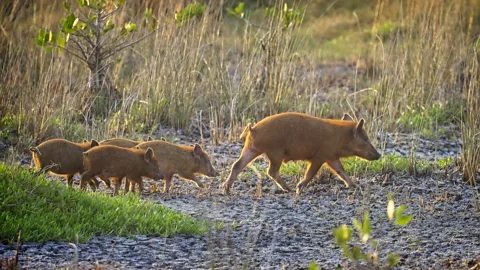 Getty Images
Getty ImagesHybridised feral pigs are considered an invasive pest in North America. But Europe's rewilding movement is rethinking the roles that this spirited animal can play.
The pop superstar Shakira experiences many forms of attention; some wanted, some not, and some in the form of wild animals. In autumn 2020, while walking with her son in a Barcelona park, she faced the latter: an assault by a pair of bag-snatching wild boars. "They've destroyed everything," she later said of her boar-torn purse.
The singer's assailants are not uncommon in urban Europe. Once hunted at scale (and to extinction in the UK), the naturally reclusive wild boar is on the rise again across the continent. And, from the beaches of Marbella to the streets of Rome, they are also becoming increasingly bold; nosing their way into both handbags and headlines by biting backsides, accosting shoppers, and prompting curfews to protect residents. In Berlin recently, authorities believe one of the city's 3,000-5,000 "wildschwein" was even mistaken for a lion.
In North America too, concern over feral swine or hogs, as they are known in the US, is growing. First imported by European explorers more than five centuries ago, domestic escapees soon formed the continent’s first invasive populations. In the 1900s, these were joined by wild boar shipped over for hunting. Today, at least 35 US states have highly fecund wild drifts. Numbering an estimated six million and rising, these boar-domestic hybrids are thought to cause an annual $2.5bn (£2.1bn) in damage to US crops, especially peanuts and corn, as well as affecting forests and livestock.
But as wild swine have been reclaiming and expanding their range, so has a new outlook on humanity's relationship to nature been gaining ground. Known as rewilding, the European-born movement aims to return landscapes to a wilder state. One prominent means of achieving this is through "trophic" rewilding, in which missing species of large animals and plants are reintroduced or replicated. In doing so, natural processes that can encourage biodiversity are restored and ecological richness unleashed, proponents argue.
So where do wild pigs fit in? Are they welcome megafauna or menace? And in today's crowded landscapes – where some species are missing and others are invasive – can we hope to achieve a balance that works for wildlife and humanity alike?
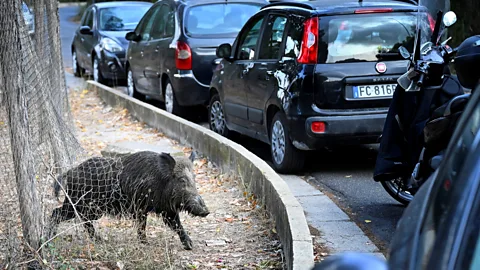 Getty Images
Getty ImagesFor Ryan Brook, professor at the University of Saskatchewan's department of animal and poultry science, "wild pigs are the worst invasive large mammal on the planet from a Canadian perspective". He and others cite the "tremendous" damage their rooting, wallowing and trampling has done to agricultural crops; as well as the threats they pose to livestock, endangered wildlife, disease transmission and water quality.
Brook's team have thus mapped the hogs' advance across Canada, and even identified what they call a "super pig" – a fast-breeding hybrid that is well-adjusted to cold climates. A group started by researchers, called "Squeal on Pigs", is now on the lookout for their spread across the border.
Inside the US, there is already a national programme working to see existing wild pig numbers controlled or, "where feasible", eradicated. Considering their conservation threats and the economic damage their spread has led to, this approach receives widespread support.
"Economically and ecologically, the hog invasion has had an overwhelmingly negative effect," says Marc Hensel, a coastal ecologist at the University of Florida's Nature Coast Biological Station.
And yet, alongside recognition of the need to control numbers and prevent habitat destruction, there is also a smaller strand of conservation science, which Hensel is helping feed into, that is starting to think more holistically about how boar behaviour reshapes the ecosystems of natural areas.
Sign up to Future Earth
Sign up to the Future Earth newsletter to get essential climate news and hopeful developments in your inbox every Tuesday from Carl Nasman. This email is currently available to non-UK readers. In the UK? Sign up for newsletters here.
In England, where boar are native and roamed among elephants and aurochs in prehistoric times, one woman in particular has been pressing the case for a reset when it comes to boars' place in the landscape. Having originally studied wild boar's interactions with humans for her environmental science master's degree, Chantal Lyons has since developed her findings into a book, Groundbreakers: The return of Britain's wild boar. She even temporarily moved house – to the historic Forest of Dean, one of the few places where boar have made a return in the UK – in order to better observe the creatures.
Lyons' familiarity shines through in her descriptions. Adult males can reach up to 150cm (59in) from snout to tail; females are smaller though still muscular. They have fluffy and pointed ears, "like an elven teddy bear". And while she notes that, in Europe, wild boar are known to scavenge or prey on everything from adders to capercaillie, or wood grouse, she is also sceptical that their full ecological impacts have been given the level of scientific study they deserve.
Evidence for their negative impact on UK wildlife is patchy, she argues. Astudy of hazel dormouse populations, for instance, only compared boar-ish locations to sites inside the national dormouse monitoring programme. Meanwhile, concerns about boar's tendency to clog waterways with sediment could be offset, she suggests, by the reintroduction of beavers to create dams that catch the dislodged earth.
Plus there are numerous benefits wild boar can bring, Lyons and others urge. They point to the way their rooting breaks open and mixes soil layers, helps less competitive plants to flourish, can encourage biodiversity and opens up foraging opportunities for other creatures.
At Knepp rewilding estate in West Sussex, UK, for instance, Tamworth pigs have been introduced as wild boar proxies. This, the founders argue, has helped clear space for plants which have, in turn, supported the return of purple emperor butterflies and endangered turtle doves. A study in France has also shown that boar's rootling can even support woodland ground-nesting birds by suppressing rodents, notes Benedict Macdonald in his book Cornerstones: Wild forces that can change our world.
These positive impacts should be a wake-up call, Lyons writes, encouraging the UK not just to rewild boar, but also ourselves. We must "re-root" ourselves alongside them, she argues, and learn to live more lightly on this degraded planet we've built. "Rewilding can and must enfold us all if we're to break the pattern of mistakes that have led to this critical planetary point."
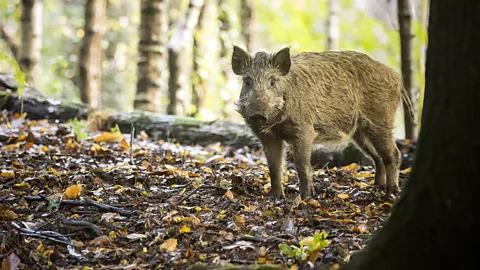 Getty Images
Getty ImagesBut what about in North America, where wild boar are not native? There is evidence to suggest feral pigs' benefits might still apply there too. Not just because they could be proxies for extinct species of peccaries, but because nativeness might not be a useful basis on which to judge their impact.
Jens-Christian Svenning from Aarhus University's DNRF Center for Ecological Dynamics in a Novel Biosphere, is an expert on trophic rewilding. In a recent metanalysis of over 200 studies, the Danish scientist and others found no difference between the impacts on plants of native and introduced large herbivorous mammals. "Nativeness doesn't matter, but animal traits do," he says.
And while, in the short term, boar's rooting and trampling can clear whole swathes of vegetation, studies from Argentina to California suggest that the longer-term effects often promote plant diversity.
How damaging they are "depends upon what you care about", says Peter Kotanen, a biological invasions specialist at the University of Toronto Mississauga. In his research at a California coastal prairie, he found that boar disturbance disrupted sensitive native grassland and promoted non-native grasses, but also encouraged the growth of small annual plants including native species.
"[The science] is complicated. We've found positive and negative effects," Kotanen says, while noting that the impact on plants is also "only the tip of the iceberg" in terms of their wider footprint on the environment.
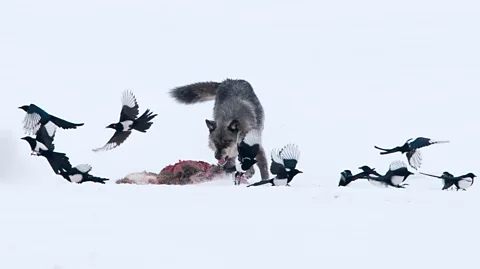 Getty Images
Getty ImagesSo what is the optimal number of wild boar in an ecosystem and how should it be achieved?
Current control strategies include recreational hunting: in Louisiana, you can hunt them by helicopter; in Germany, there's a trend for daggers and spears. Plus there are also natural methods, such as the return of wolves or bears. But Brook is sceptical that either of these options will achieve much.
Sport hunting is not a viable option, Brook says. "Hunter success in western Canada is about 3% and in fact hunting makes the problem much worse because it breaks up sounder groups and spreads them around the landscape." The practice also makes them more elusive and nocturnal and gets "in the way of government-led control programmes". Nor does he believe predation can be relied upon, since he says wild pigs are mostly distributed in areas without wolves.
Svenning agrees that natural predation is unlikely to be a major control measure for boar, noting that food availability in Europe's forest ecosystems plays a much larger role. But he also points to research suggesting that the return of predators like wolves might also help create an ecology of fear in which the boar's space use might become more variable. "Facilitating the return of wolves and cougars in North America is expected to promote more positive ecosystem impacts by the pigs," says Svenning. "Even if they don't strongly limit pig abundance, they might create a landscape of fear, promoting more variable space use, and thereby generating safe areas for sensitive species."
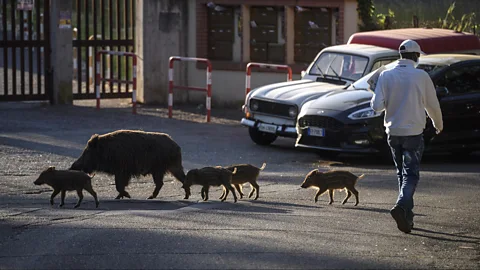 Getty Images
Getty ImagesStill, even with control strategies in place, there's also not enough information yet to know what numbers are optimal in different landscapes.
Hensel has researched the impact of wild hogs on plants in both salt and brackish marshes in the US, and has found that while wild hogs knock back competitive and dominant plants (with woody root systems), they also allow smaller plants to come in. Whether this is good or bad for brackish marshes, however, Hensel explains, "depends on what your interest is". Plant biodiversity can be good for insects and birdlife, but large amounts of woody biomass from dominant species can help sequester carbon and protect against coastal erosion in the face of worsening climate change.
Boars' value to an ecosystem also depends, Hensel notes, on the context in which they are being reintroduced or expanding. One study has estimated that, globally, hog soil disturbance causes the same emissions as 1.1 million cars; yet another predicts that, when part of a wider rewilding effort, the reintroduction of large animals that restore natural processes can be an essential climate solution.
Ultimately, both Hensel and Svenning suggest, more research is needed on wild boars long-term and large-scale impacts – not just on plants, but on other kinds of species interactions too.
Carbon Count
The emissions from travel it took to report this story were 0kg CO2. The digital emissions from this story are an estimated 1.2g to 3.6g CO2 per page view. Find out more about how we calculated this figure here.
But what can't be avoided is the fact that big mammals, like boar, are making a comeback – and that the landscapes they're emerging into look very different from those they inhabited in prehistoric times. Their presence may thus cause a lot of economic damage, but they're also "probably just doing similar things to what pigs did in the Pleistocene, except now we don't have any predators to keep their numbers in check", says Hensel.
The challenge now for conservationists is to work out how the ecological rulebook has changed with the arrival of climate change, the loss of natural predators, human population growth and species invasions. "We need a new management blueprint," Hensel says.
Until new research makes that possible, the overall impact of wild boars' return will likely remain a "conservation conundrum," he says.
--
If you liked this story, sign up for The Essential List newsletter – a handpicked selection of features, videos and can't-miss news delivered to your inbox every Friday.
